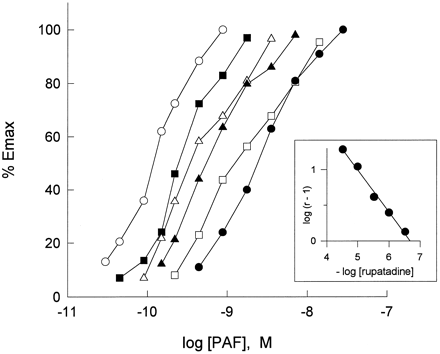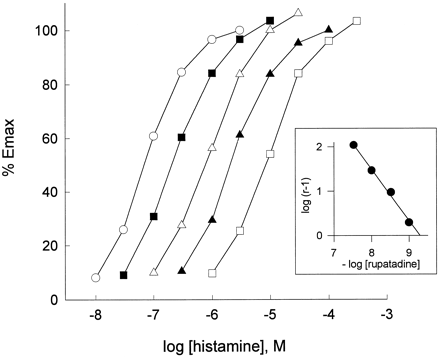
| Size | Price | Stock | Qty |
|---|---|---|---|
| 100mg |
|
||
| 250mg |
|
||
| 500mg |
|
||
| 1g |
|
||
| 2g |
|
||
| Other Sizes |
|
Purity: ≥98%
Rupatadine Fumarate (UR-12592; UR12592; Pafinur; Rupax; Rupafin; Alergoliber; Rinialer; Ralif), the fumarate salt of Rupatadine, is a potent inhibitor of PAFR and antagonist of histamine (H1) receptor used to treat allergies. Its Kis values for the PAFR and histamine (H1) receptors are 550 nM and 102 nM, respectively.
| Targets |
H1 Receptor ( Ki = 0.1 μM ); PAF ( Ki = 0.55 μM )
|
||
|---|---|---|---|
| ln Vitro |
|
||
| ln Vivo |
|
||
| Enzyme Assay |
For 30 minutes at 25 °C, antagonists are incubated with guinea pig cerebellum membranes (0.6 mg/ml) and [3H]-pyrilamine (1.2 nM) in 0.5 ml of 50 mM PBS. The membranes are collected on Whatman GF/B filters and 5 ml of ice-cold PBS containing 2 μM pyrilamine is added to end the incubation. After that, the filters are placed in counting vials after being cleaned with 3 x 5 ml of ice-cold PBS plus 2 μM pyrilamine. Liquid scintillation counting in 3 ml of HiSafe 3 is used to determine the amount of radioactivity retained by each filter. The difference between the [3H]-pyrilamine bound in the absence and in the presence of a large molar excess (10 μM) of unlabeled promethazine allows for the determination of specific binding.
|
||
| Cell Assay |
C18-PAF is used to induce platelet aggregation, which is then measured with a dual-channel aggregometer Chrono-log 560. Platelet aggregation is measured both with and without the test compounds (5-min incubation). The inhibitors' activity is represented by their IC50 values. Rupatadine is tested in WRP against other aggregating agents, such as arachidonic acid (1 mM) and ADP (5 μM), in order to determine its selectivity. Rupatadine is present at different concentrations (3 × 10-7–3 × 10-5 M) and in the absence to obtain dose-response curves for PAF-induced aggregation in WRP.
|
||
| Animal Protocol |
|
||
| References | |||
| Additional Infomation |
Drug Indication
Treatment of allergic rhinitis, Treatment of chronic idiopathic urticaria |
| Molecular Formula |
C30H30CLN3O4
|
|
|---|---|---|
| Molecular Weight |
532.03
|
|
| Exact Mass |
531.192
|
|
| Elemental Analysis |
C, 67.73; H, 5.68; Cl, 6.66; N, 7.90; O, 12.03
|
|
| CAS # |
182349-12-8
|
|
| Related CAS # |
Rupatadine; 158876-82-5; Rupatadine-d4 fumarate; 1795153-63-7
|
|
| PubChem CID |
6449107
|
|
| Appearance |
White to off-white solid powder
|
|
| Boiling Point |
586.4ºC at 760 mmHg
|
|
| Melting Point |
58-61ºC
|
|
| Flash Point |
308.4ºC
|
|
| LogP |
5.284
|
|
| Hydrogen Bond Donor Count |
2
|
|
| Hydrogen Bond Acceptor Count |
7
|
|
| Rotatable Bond Count |
4
|
|
| Heavy Atom Count |
38
|
|
| Complexity |
728
|
|
| Defined Atom Stereocenter Count |
0
|
|
| SMILES |
ClC1C([H])=C([H])C2=C(C=1[H])C([H])([H])C([H])([H])C1C([H])=C([H])C([H])=NC=1/C/2=C1/C([H])([H])C([H])([H])N(C([H])([H])C2=C([H])N=C([H])C(C([H])([H])[H])=C2[H])C([H])([H])C/1([H])[H].O([H])C(/C(/[H])=C(\[H])/C(=O)O[H])=O
|
|
| InChi Key |
JYBLCDXVHQWMSU-WLHGVMLRSA-N
|
|
| InChi Code |
InChI=1S/C26H26ClN3.C4H4O4/c1-18-13-19(16-28-15-18)17-30-11-8-20(9-12-30)25-24-7-6-23(27)14-22(24)5-4-21-3-2-10-29-26(21)25;5-3(6)1-2-4(7)8/h2-3,6-7,10,13-16H,4-5,8-9,11-12,17H2,1H3;1-2H,(H,5,6)(H,7,8)/b;2-1+
|
|
| Chemical Name |
(E)-but-2-enedioic acid;13-chloro-2-[1-[(5-methylpyridin-3-yl)methyl]piperidin-4-ylidene]-4-azatricyclo[9.4.0.03,8]pentadeca-1(11),3(8),4,6,12,14-hexaene
|
|
| Synonyms |
|
|
| HS Tariff Code |
2934.99.9001
|
|
| Storage |
Powder -20°C 3 years 4°C 2 years In solvent -80°C 6 months -20°C 1 month Note: Please store this product in a sealed and protected environment, avoid exposure to moisture. |
|
| Shipping Condition |
Room temperature (This product is stable at ambient temperature for a few days during ordinary shipping and time spent in Customs)
|
| Solubility (In Vitro) |
|
|||
|---|---|---|---|---|
| Solubility (In Vivo) |
Solubility in Formulation 1: ≥ 2.08 mg/mL (3.91 mM) (saturation unknown) in 10% DMSO + 40% PEG300 + 5% Tween80 + 45% Saline (add these co-solvents sequentially from left to right, and one by one), clear solution.
For example, if 1 mL of working solution is to be prepared, you can add 100 μL of 20.8 mg/mL clear DMSO stock solution to 400 μL PEG300 and mix evenly; then add 50 μL Tween-80 to the above solution and mix evenly; then add 450 μL normal saline to adjust the volume to 1 mL. Preparation of saline: Dissolve 0.9 g of sodium chloride in 100 mL ddH₂ O to obtain a clear solution. Solubility in Formulation 2: ≥ 2.08 mg/mL (3.91 mM) (saturation unknown) in 10% DMSO + 90% (20% SBE-β-CD in Saline) (add these co-solvents sequentially from left to right, and one by one), clear solution. For example, if 1 mL of working solution is to be prepared, you can add 100 μL of 20.8 mg/mL clear DMSO stock solution to 900 μL of 20% SBE-β-CD physiological saline solution and mix evenly. Preparation of 20% SBE-β-CD in Saline (4°C,1 week): Dissolve 2 g SBE-β-CD in 10 mL saline to obtain a clear solution. View More
Solubility in Formulation 3: ≥ 2.08 mg/mL (3.91 mM) (saturation unknown) in 10% DMSO + 90% Corn Oil (add these co-solvents sequentially from left to right, and one by one), clear solution. Solubility in Formulation 4: 30% Propylene glycol , 5% Tween 80 , 65% D5W: 30 mg/mL |
| Preparing Stock Solutions | 1 mg | 5 mg | 10 mg | |
| 1 mM | 1.8796 mL | 9.3980 mL | 18.7959 mL | |
| 5 mM | 0.3759 mL | 1.8796 mL | 3.7592 mL | |
| 10 mM | 0.1880 mL | 0.9398 mL | 1.8796 mL |
*Note: Please select an appropriate solvent for the preparation of stock solution based on your experiment needs. For most products, DMSO can be used for preparing stock solutions (e.g. 5 mM, 10 mM, or 20 mM concentration); some products with high aqueous solubility may be dissolved in water directly. Solubility information is available at the above Solubility Data section. Once the stock solution is prepared, aliquot it to routine usage volumes and store at -20°C or -80°C. Avoid repeated freeze and thaw cycles.
Calculation results
Working concentration: mg/mL;
Method for preparing DMSO stock solution: mg drug pre-dissolved in μL DMSO (stock solution concentration mg/mL). Please contact us first if the concentration exceeds the DMSO solubility of the batch of drug.
Method for preparing in vivo formulation::Take μL DMSO stock solution, next add μL PEG300, mix and clarify, next addμL Tween 80, mix and clarify, next add μL ddH2O,mix and clarify.
(1) Please be sure that the solution is clear before the addition of next solvent. Dissolution methods like vortex, ultrasound or warming and heat may be used to aid dissolving.
(2) Be sure to add the solvent(s) in order.
| NCT Number | Recruitment | interventions | Conditions | Sponsor/Collaborators | Start Date | Phases |
| NCT03770923 | Recruiting | Drug: Rupatadine Drug: Montelukast |
Rheumatoid Arthritis | Sherief Abd-Elsalam | October 1, 2018 | Phase 3 |
| NCT01481909 | Completed | Drug: Rupatadin | Mastocytosis | Marcus Maurer | September 2010 | Phase 2 Phase 3 |
| NCT05356143 | Completed | Drug: Rupatadine | Healthy | J. Uriach and Company | December 2, 2021 | Phase 1 |
| NCT01605487 | Completed | Drug: Rupatadine | Cold Contact Urticaria | Charite University, Berlin, Germany |
June 2012 | Phase 2 |
| NCT01481909 | Completed | Drug: Rupatadin | Mastocytosis | Marcus Maurer | September 2010 | Phase 2 Phase 3 |
 |
|---|
 |
 |